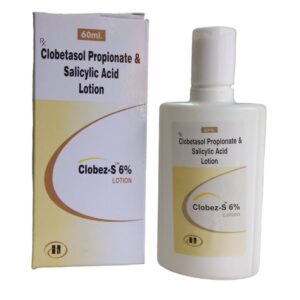CLOBETASOL + SALICYCLIC ACID
Clobetasol: Clobetasol is a potent corticosteroid medication that is used to treat various skin conditions. It belongs to a class of drugs called corticosteroids, which work by reducing inflammation, itching, and redness.
This drug is primarily used for the treatment of inflammatory skin conditions such as eczema, psoriasis, and dermatitis. It helps to provide relief from symptoms such as itching, swelling, and skin irritation. Clobetasol should only be used on the skin and is not intended for use on the face, groin, or underarms unless directed by a healthcare professional.
Clobetasol works by binding to specific receptors in the skin cells, which helps to decrease the production of inflammatory substances. This, in turn, reduces inflammation and related symptoms.
The dose of clobetasol varies depending on the condition being treated and the severity of the symptoms. It is usually applied to the affected area sparingly once or twice daily, for a maximum of two weeks. It is recommended to use the smallest amount necessary to control symptoms and to avoid prolonged use or excessive application, as it can lead to side effects.
Like any medication, clobetasol may cause side effects. The most common side effects include skin thinning, burning, itching, and redness at the application site. Prolonged use or excessive use of clobetasol can also lead to systemic side effects such as adrenal suppression, which can affect hormone levels. It is important to follow the dosing instructions provided by a healthcare professional and to discuss any concerns or potential side effects with them.
In summary, clobetasol is a potent corticosteroid medication used for the treatment of various inflammatory skin conditions. It reduces inflammation and related symptoms by binding to specific receptors in the skin cells. The dose and duration of use should be determined by a healthcare professional, and potential side effects should be monitored.
Salicyclic Acid: Salicylic acid is a medication that belongs to the class of drugs known as keratolytics. It is commonly used in the treatment of various skin conditions, including acne, dandruff, psoriasis, and warts.
The primary mechanism of action of salicylic acid is its ability to penetrate and loosen the outer layer of the skin, thereby promoting the shedding of dead skin cells. It also has anti-inflammatory properties, which can help reduce redness and swelling associated with skin conditions.
The dose and application of salicylic acid depend on the specific condition being treated. It is available in various forms, including creams, gels, liquids, and medicated patches. Generally, it is applied topically to the affected area once or twice daily. It is important to follow the instructions provided by your healthcare professional or the product label.
Although salicylic acid is generally considered safe, it can cause certain side effects. Common side effects include skin irritation, redness, dryness, and peeling. These side effects are usually mild and transient. However, if you experience severe skin irritation or any other concerning symptoms, it is advisable to stop using the medication and consult your healthcare professional.
Some individuals may be more sensitive to salicylic acid, and they may be more prone to experiencing side effects. It is important to note that salicylic acid should not be used on large areas of the body, broken or irritated skin, or on mucous membranes. It is also not recommended for use during pregnancy or while breastfeeding without consulting a healthcare professional.
As with any medication, it is recommended to consult with a healthcare professional before starting salicylic acid treatment to determine if it is appropriate for your specific condition and to discuss any potential interactions or contraindications with other medications you may be taking.

